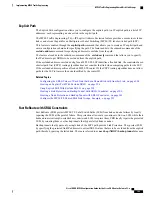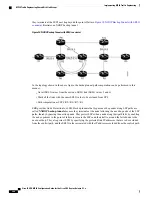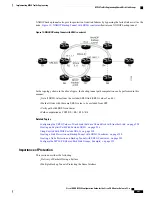
Stateful PCE State Synchronization
Synchronization refers to a procedure that occurs after a PCEP session is established between a PCE and a
PCC. The purpose of state synchronization is to download the current LSP database of the PCC to a PCE.
This is done through a set of state reports which are marked as
synchronizations
. This is the first communication
to occur after the session is brought up. A full re-send of state reports can also be avoided when the PCE
already has an up-to-date version of the LSP database as the version number can be indicated by the PCE
during PCEP session establishment.
Stateful PCE Delegation
Delegation is the action by which control of a state is granted to a PCE by the PCC. A PCE to which control
was delegated can alter attributes of the LSP. Control is only delegated to one PCE at a time.
•
Delegation of control can be revoked from a PCE by the PCC.
•
Delegation of control can also be returned to the PCC by the PCE.
Stateful PCE State Updating
State updating refers to the PCE sending information to a PCC to alter the attributes of an LSP. A state update
is a message sent by a PCE to a PCC to alter the state of one or more TE tunnels. State updating is allowed
only if the PCE has previously been delegated control of the LSP. State updating is also used to return delegated
control.
Stateful PCE Creation of LSPs
Creation (or instantiation) of an LSP is a procedure by which a PCE instructs a PCC to create an LSP respecting
certain attributes. For LSPs created in this manner, the PCE is delegated control automatically. Stateful PCE
procedures enable a PCE to instruct a PCC to create a locally sourced tunnel.
MPLS TE Usability Enhancements
MPLS traffic engineering command line interface and logging output messages are enhanced as follows:
•
The
show mpls traffic engineering
commands display
signaled-name
and supports
signaled-name
filter.
•
Ability to allow immediate teardown of all labelled switched paths ( LSPs) of the specified tunnel and
to create new LSPs.
•
Default behavior when affinity check fails at head-end is to reoptimize all LSP types.
•
Logging output messages include MPLS TE tunnel signaled name.
•
Logging of path change events and available bandwidth on the new for all auto-bandwidth operations.
•
Auto-bandwidth logging output includes signaled name.
Cisco IOS XR MPLS Configuration Guide for the Cisco CRS Router, Release 5.1.x
210
Implementing MPLS Traffic Engineering
MPLS TE Usability Enhancements









































